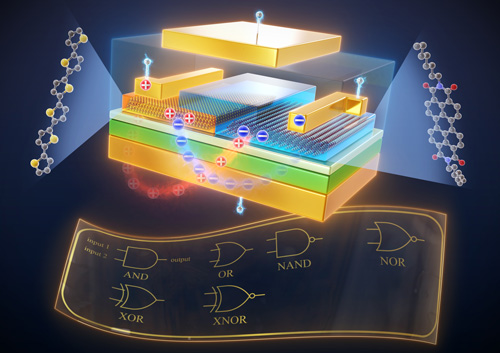- Home
- > Research
- > Research Highlights
- > Vol. 79 Insight into Organic Antiambip・・・
 Research Highlights
Research Highlights
[Vol. 79]
Insight into Organic Antiambipolar Transistors
MANA researchers have elucidated the mechanism behind organic antiambipolar transistors (OAATs), a new class of transistors with possible applications in artificial intelligence and neuromorphic devices.

Transistors are one of the basic building blocks of modern technology and electronics. The emergence of artificial intelligence and brain-like devices has brought about a need for multiple logic gate operations to be conducted on the same transistor chip. Even the gold standard, complementary metal-oxide semiconductor (CMOS) transistors, cannot handle such a large load of operations. Hence, the search is on for technologies that can.
Researchers from MANA, led by Dr. Ryoma Hayakawa, have been investigating a new class of transistors, OAATs. OAATs can support multiple logic gate operations owing to a unique property called negative differential transconductance (NDT). The research team’s extensive work, directed by Dr. Yutaka Wakayama, has looked to first elucidate the charge-carrier mechanism in these devices, and then also apply them to multiple logic gate operations. "We needed to know how OAATs work so that they could then be improved upon. So, we directly visualized the electron flow in an OAAT, using a technique called operando photoemission electron microscopy (PEEM). We were then able to understand where the transistor junction gets its exciting switchable property," explains Wakayama.
The PEEM experiments showed that a depletion layer is formed at the lateral p-n interface; this generates a large potential difference, enhancing electron conduction in the transistor. Armed with this knowledge, the research team looked at its applicability. "By adjusting input voltages across OAATs, we could achieve five different logic gate operations on the same device. We could even switch between two logic gates with a given set of inputs," explains Wakayama.
OAATs are stable and reliable, operating for months. They can surpass CMOS devices for many applications. Keeping this in mind, the work done at MANA could lead to a massive reduction in the number of transistors required in current integrated circuits and improve their processing ability, enabling the development of more advanced technology that can handle large amounts of operations.
Researchers from MANA, led by Dr. Ryoma Hayakawa, have been investigating a new class of transistors, OAATs. OAATs can support multiple logic gate operations owing to a unique property called negative differential transconductance (NDT). The research team’s extensive work, directed by Dr. Yutaka Wakayama, has looked to first elucidate the charge-carrier mechanism in these devices, and then also apply them to multiple logic gate operations. "We needed to know how OAATs work so that they could then be improved upon. So, we directly visualized the electron flow in an OAAT, using a technique called operando photoemission electron microscopy (PEEM). We were then able to understand where the transistor junction gets its exciting switchable property," explains Wakayama.
The PEEM experiments showed that a depletion layer is formed at the lateral p-n interface; this generates a large potential difference, enhancing electron conduction in the transistor. Armed with this knowledge, the research team looked at its applicability. "By adjusting input voltages across OAATs, we could achieve five different logic gate operations on the same device. We could even switch between two logic gates with a given set of inputs," explains Wakayama.
OAATs are stable and reliable, operating for months. They can surpass CMOS devices for many applications. Keeping this in mind, the work done at MANA could lead to a massive reduction in the number of transistors required in current integrated circuits and improve their processing ability, enabling the development of more advanced technology that can handle large amounts of operations.
Reference
“Carrier-Transport Mechanism in Organic Antiambipolar Transistors Unveiled by Operando Photoemission Electron Microscopy”
Ryoma Hayakawa, Soichiro Takeiri, Yoichi Yamada, Yutaka Wakayama, and Keiki Fukumoto.
Journal: Advanced Materials, 2022, 34, 2201277 (June 19 2022)
DOI : 10.1002/adma.202201277
“Electrically Reconfigurable Organic Logic Gates: A Promising Perspective on a Dual-Gate Antiambipolar Transistor”
Ryoma Hayakawa, Kosuke Honma, Shu Nakaharai, Kaname Kanai, and Yutaka Wakayama.
Journal: Advanced Materials, 2022, 34, 2109491 (February 27 2022)
DOI : 10.1002/adma.202109491
Ryoma Hayakawa, Soichiro Takeiri, Yoichi Yamada, Yutaka Wakayama, and Keiki Fukumoto.
Journal: Advanced Materials, 2022, 34, 2201277 (June 19 2022)
DOI : 10.1002/adma.202201277
“Electrically Reconfigurable Organic Logic Gates: A Promising Perspective on a Dual-Gate Antiambipolar Transistor”
Ryoma Hayakawa, Kosuke Honma, Shu Nakaharai, Kaname Kanai, and Yutaka Wakayama.
Journal: Advanced Materials, 2022, 34, 2109491 (February 27 2022)
DOI : 10.1002/adma.202109491
Affiliations
International Center for Materials Nanoarchitectonics (WPI-MANA), National Institute for Materials Science (NIMS), Namiki 1-1, Tsukuba, Ibaraki 305-0044, Japan
Contact information
Research Center for Materials Nanoarchitectonics (MANA)
National Institute for Materials Science
1-1 Namiki, Tsukuba, Ibaraki 305-0044 Japan
Phone: +81-29-860-4710
E-mail: mana-pr[AT]nims.go.jp
1-1 Namiki, Tsukuba, Ibaraki 305-0044 Japan
Phone: +81-29-860-4710
E-mail: mana-pr[AT]nims.go.jp

